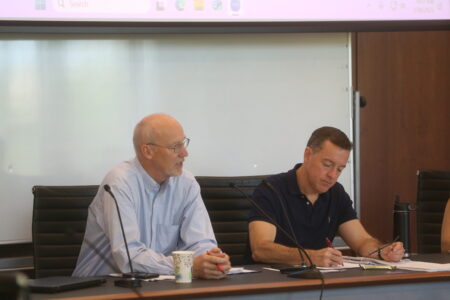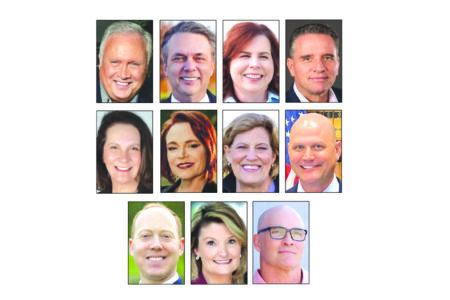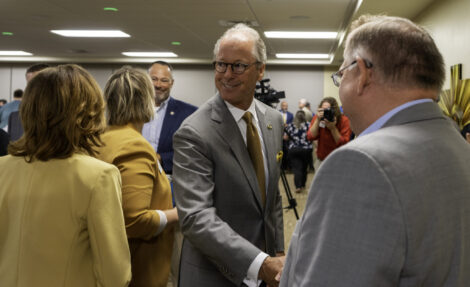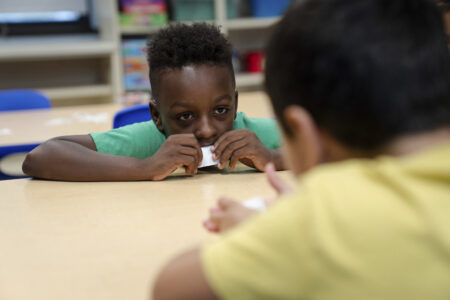KU’s to-do list: Right-size the Lawrence campus; new master plan says it may be 20% too large

photo by: Chad Lawhorn/Journal-World
University of Kansas Provost Barbara Bichelmeyer discusses KU's 10-year master plan with the Kansas Board of Regents on Sept. 18, 2024.
During the next 10 years the University of Kansas may be able to get rid of 20% of all of its building space on the Lawrence campus, according to KU’s recently completed master plan.
In fact, the plan says if KU wants to remain financially and environmentally healthy, it needs to seriously consider getting rid of about 1 million square feet of building space on the Lawrence campus.
“Our analysis confirmed that the financial, environmental, and people cost of ‘business as usual’ — in other words, maintaining KU’s current physical footprint — is no longer sustainable,” KU’s new master plan states. “KU must evolve to remain relevant.”
KU leaders on Wednesday presented the master plan to the Kansas Board of Regents, which oversees the state’s public universities. Regents, who unanimously approved the plan, long have been asking universities to look for ways to reduce their building inventories on campuses as costs to maintain those buildings are eating into university operating budgets. KU estimates it has $750 million worth of maintenance that it needs to conduct if it wants to continue using all its buildings.
KU Chancellor Douglas Girod told the Journal-World in a brief interview that KU’s new master plan takes that directive seriously, but he also said accomplishing the reduction will be challenging. Not only are building demolitions sometimes controversial, but the mindset that faculty and staff likely will have to adopt also will be challenging.
“We definitely have to share more,” Girod said.
The team of consultants and KU leaders who put together the master plan found that there are many classrooms and lab spaces that frequently aren’t used during large parts of the day because certain schools or researchers have a “prevailing culture of ownership of rooms and in some cases entire buildings.”
The master plan recommends that KU create a new master scheduling system that will give the university’s registrar the ability to assign uses to classrooms across the university, meaning some buildings that house particular schools may be hosting classes that aren’t related to that school’s offerings.
The plan also proposes the creation of a new research space committee that will meet multiple times per year to hear reports on laboratory space that is underutilized and make recommendations to the provost about how that lab space can be shared by other researchers or classes.
What the plan does not do is provide a specific list of buildings that it recommends for demolition. There’s work to do in creating that list, and Girod said it likely won’t be straightforward in many cases.
He said there are very few buildings left on campus that are 100% unused. Instead, there are buildings that may have 20% to 30% of space that is unused. Since it is often infeasible to demolish or mothball just a portion of a building, the Regents were told that university planners likely will have to look at how certain people or offices could be moved to other buildings.
“The challenge of shrinking is moving people out, and where you put them when you are moving them out,” said Provost Barbara Bichelmeyer, who oversaw efforts to create the master plan.
In some cases, moving people out of a building may mean that the university builds a new building to house them. But university leaders said the amount of square footage added to campus is likely to be less than the space that is removed.
“We simply cannot afford to build many new buildings,” Bichelmeyer said.
The master plan envisions only two new buildings being constructed over the next 10 years. Plans call for a new student wellness center to be built near the Ambler Student Recreation Center to replace the aged Watkins Memorial Health Center. That $42 million project could win approvals within the next year, according to the plan.
The master plan also calls for a new Interdisciplinary Science Building that would add more than 200,000 square feet of laboratory and classroom space on a site just west of the Burge Union. When that $250 million project, which likely would be built in phases, would be constructed isn’t specified in the plan. The building largely would replace laboratory and classroom space in Malott and Haworth halls.
Bichelmeyer stopped short of saying Malott and Haworth were examples of buildings that ultimately may be razed, but she said they are prime examples of buildings that are in poor condition.
“I can’t begin to tell you how challenged we are with conditions there,” Bichelmeyer said.
Bichelmeyer said the university does have condition reports on all major buildings on campus, and the master plan has created a digital dashboard that university planners can access to make plans for demolitions and other changes to campus space.
While the master plan document doesn’t list those condition reports, it does provide data about the types of university spaces that are currently empty or underutilized. The master plan found:
• Classroom space could be reduced by 132,000 square feet, if the university is successful in creating a centralized scheduling system.
• Research space could be reduced by 166,000 square feet, as the master plan found that there was significant duplication of support facilities in KU’s research enterprises. “More shared facilities could both reduce excess square footage and enhance interdepartmental collaboration.”
• Office space could be reduced by 370,000 square feet based off of KU’s current workplace environments. However, the plan found that approximately 600,000 square feet — half of all office space on the Lawrence campus — could be reduced if KU adopts more hybrid and remote work styles for office employees. Authors of the plan said they did find some office spaces on campus that “had visibly not been used in years.”
In total, the plan found opportunities to reduce 940,000 square feet of “assignable” space — meaning space that doesn’t count areas like hallways, stairwells and mechanical rooms. That equates to 20% of all assignable space on the Lawrence campus, according to the master plan.
“In summary, there is significant potential for right-sizing the Lawrence campus,” the master plan found.
The master plan, nearly 130 pages in length, produced recommendations and findings on many other topics. They include:
• 90% of KU’s students currently come from Kansas, Missouri and Illinois. However, the number of high school graduates each of those states is projected to produce between 2019 and 2037 is expected to drop significantly. Kansas is expected to see a 13% decline, Missouri a 7% decline and Illinois a 24% decline. Those numbers are driving KU’s strategy to offer more online classes that can more easily be offered to students around the world. The university also is developing new degree or certificate programs that are designed for older students who may need particular training or skills to advance their careers.
• KU should consider consolidating many of its parking lots on the Lawrence campus and replacing them with parking garages. The consolidation of parking lots would allow for current parking lots to be converted into green space, the report said.
• Multiple improvements could be made along Jayhawk Boulevard to allow the main street through the heart of campus “to truly become the campus’ living room.” The plan particularly calls for the approximately 3 acres of green space that is in front of Fraser Hall and Watson Library to become the “Jayhawk Quad.” Improvements could include a more robust tree canopy, additional seating for individuals and groups, and dedicated programming and events for the space.
• Wescoe Hall, with its “brutalist style,” was cited by survey participants as one of the “most disliked buildings” on campus. The plan said the university should look for ways to add more glass to the exterior of the building. It also said the landscaping around the building could be improved. The plan recommends a sculpture pavilion between Wescoe and Budig Hall. It also said a small amphitheater could be created near the building.
Bichelmeyer said improvements of community gathering spaces on campus are going to be important in the years to come. She said spaces where people can come together, whether to collaborate or simply get to know each other, is what makes them feel a need to come to campus — even more so than time in a classroom.
“They can get a lecture on YouTube,” she said, “and don’t have to walk up a hill to do it.”







